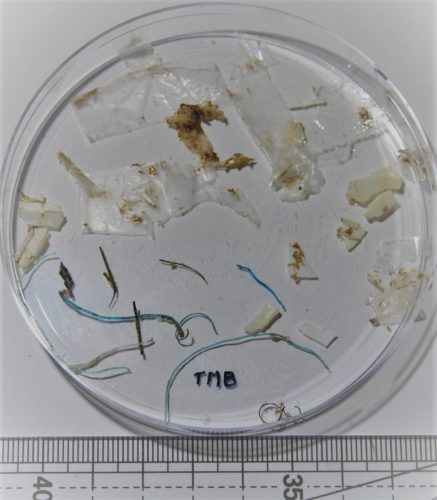Nuria Felis, under the supervision of the Campus Gandia professors Silvia Falco and Miguel Rodilla, has conducted the first study on microplastic density the southern area of the Gulf of Valencia in her Master’s Thesis for the Masters Program in Environmental Assessment and Monitoring of Marine and Coastal Ecosystems of the Universitat Politècnica de València.
The results of this study indicate a higher concentration of microplastics at the mouths of the Júcar and Serpis rivers, with an average of 329,500 items per square kilometer. This figure indicates a high level of contamination of these compounds, similar to that of other areas of the Mediterranean, although with a somewhat better situation than the one known in the so-called “Plastic Island”, located in the northern Pacific turn.

Nuria Felis in the laboratory at Campus Gandia
To identify and quantify them, Felis has taken samples of the marine surface layer of ten sectionst that are perpendicular to the 54-kilometer segment of the Valencian coast that goes from Cullera to Denia.
Thanks to this study, significant differences between the density of microplastics have been discovered in the Serpis and Marenyet area (south of the mouth of the Júcar), with an average of over 900,000 items per square kilometer, compared to areas such as Piles and Oliva Nova, which have an average density close to 100,000 items per square kilometer
Felis points out that 66% of microplastics from the degradation of macroplastics have been found, which would point to a connection between their presence at sea and contamination from larger plastics.
Report from the program “Terra Viva” on À Punt
THE SOURCE OF THE MICROPLASTICS
 Around 80% comes from land sources, such as rivers or irrigation canals, which are washed away by runoff and transported by currents.The scientist describes two types of microplastics: primary and secondary. The primary ones are the micro spheres found in pharmaceutical and cosmetic products, such as toothpaste or scrubs and exfoliants. The secondary ones come from fragments of large plastics that are produced by the action of erosive agents.
Around 80% comes from land sources, such as rivers or irrigation canals, which are washed away by runoff and transported by currents.The scientist describes two types of microplastics: primary and secondary. The primary ones are the micro spheres found in pharmaceutical and cosmetic products, such as toothpaste or scrubs and exfoliants. The secondary ones come from fragments of large plastics that are produced by the action of erosive agents.
According to Felis, “the combination of ultraviolet radiation, the force of the waves, the temperature and the availability of oxygen and turbulence, together with the properties of plastic polymers, influence the fragmentation of plastic waste.” As for the reason that these compounds end up at sea, she explains that their small size prevents them from being retained in any of the treatment stages in wastewater treatment plants.
PRESENCE OF MICROPLASTICS IN WILDLIFE
The researcher warns that the presence of microplastics in the marine environment indirectly affects people via wildlife, since there size is less than 5 millimeters and are easily ingested by mollusks or plankton, which larger organisms in the food chain feed on before reaching human consumption. “Given the importance of this type of pollution, we wanted to do a first approximation of the presence of microplastics on our coasts. This way, when we decide to implement measures, we will be able to pinpoint the priority issues.” Currently, Nuria Felis continues to do research for her doctoral dissertation, also focused on microplastics.











